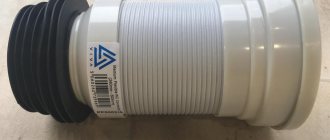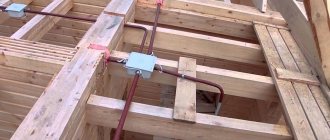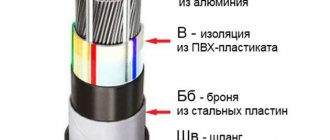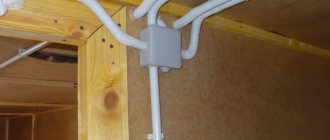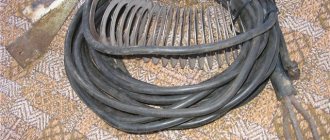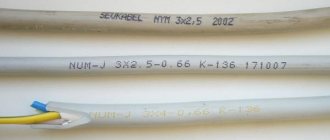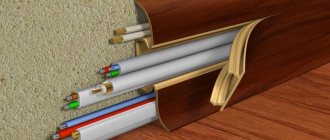Main types and types
Before moving on to the main topic of our article, let's figure out what kind of cables there are.
Control cables usually consist of a set of cores from a couple to several dozen. Used for assembling control circuits and connecting groups of sensors and actuators. Can be shielded - this will help avoid interference and give additional strength to the product. An example of such a cable is KVVG - copper with PVC insulation. At the beginning of the marking of such cables there is usually the letter K.
KVVG
Information and signal cables. These include twisted pair and fiber optic. Optical fiber can be single-mode or multimode, depending on its purpose and design. Telephone “noodles” also belong to this class. Twisted pair cables can be supplemented with screens and protective sheaths, like other types of cable products.
Armored twisted pair cable for external installation, self-supporting
Power cables are used to connect electrical equipment to the power supply. If the first letter in the marking is A - for example, AVVG, then the cores in it are made of aluminum. If there is no letter A, for example VVG, then it is copper. The remaining letters tell us about the insulation materials and the presence of additional components. VVG stands for Vinyl-Vinyl-Bare, that is, two layers of PVC insulation and a bare core.
VVG 4×1.5
Power armored is a separate type of product designed for operation in difficult conditions in aggressive cutting or under possible mechanical stress, including in the ground. Information cables can also be protected by armor. They can be either aluminum or copper. An example is an armored copper cable VBBShV with insulation made of cross-linked polyethylene and a sheath made of pressed PVC hose, and armor made of steel tapes, you will learn more about this below.
VBBSHV with five cores
A special word needs to be said about the load-carrying geophysical cable - this is a type of armored product used for research purposes in the oil and gas industry, in marine and geological expeditions. It has another name - logging.
Logging cable
Material of manufacture
Armored cables are divided into two types. The first drive is made of copper alloy. The second type of cable consists of aluminum. Each of them conducts electricity for its field of activity.
Copper armored cable
This material has good ductility. When installing it, insulation is required.
- In this case, the cable ideally conducts electric current of any voltage.
- Copper cable can be placed near air conditioners and radiators without worrying about unforeseen consequences.
- The drive is used to connect power transformers.
As a rule, this type of cable is not designated in any way, but if you consider that the aluminum drive is designated by the letter <<A>>. This means that a product without an icon will be a copper drive.
Aluminum armored cable
Aluminum drive does not have good ductility. But one can only envy its strength. The drive can withstand high voltage with a heat capacity of 890 J/kg. The armor is almost impossible to damage, as it has great resistance.
At the same time, aluminum cables differ in the type of insulating material. Which is made of plastic, polyethylene and polymer. Each of these materials has its own characteristics.
Marking of cables with a layer of armor
Protected products often have fairly long markings. To learn how to recognize brands of armored cables, you need to figure out what the letters in the markings mean, for this we will look at the example of several brands.
For armored cable AVBbShv the marking means:
- A - aluminum conductors;
- B - vinyl internal insulation;
- B - armored;
- b - without a pillow;
- Shv - outer sheath in the form of a pressed PVC hose.
VBBShvng, similar to it, stands for this:
- there is no letter “A” at the beginning, which means the wires are made of copper;
- B - vinyl internal insulation;
- B - armored;
- b - without a pillow;
- Shv - outer sheath in the form of a pressed PVC hose.
- ng - does not spread fire.
The third brand TPPepB is an armored telephone, which stands for:
- T - speaks about the purpose - “Telephone”;
- P - polyethylene insulation;
- P - polyethylene insulation;
- ep - screen made of aluminum polymer tape;
- B - armor made of two table bands.
Polymer
This material includes PVC, cross-linked polyethylene and other polymer types of insulation. The polymer is used in the chemical and technical industries.
- Indicated by the marking <<П>>. The material has a number of features compared to the above insulation systems.
- The polymer is not low in price. But it functions in various electrical and thermal devices.
- Because it stands out for its high strength, easy installation, versatility and safety.
It is this safety material that is used in areas with large crowds of people.
Since when the device catches fire, the polymer has a lesser impact on human health and the environment.
Design
We’ve sorted out the approximate decoding of the markings, now let’s move on to considering the general design of armored cables. It consists of:
- A conductor made of aluminum or copper.
- A layer of insulation over the core, usually PVC, polyethylene or impregnated paper.
- Next comes a screen made of copper wires or various conductive tapes, for example, metal or conductive cardboard and paper.
- On top of the screen is another layer of insulation.
- Then comes a layer of armor, usually made in the form of tapes, then the top tape is applied so as to overlap the joints of the turns of the bottom tape. Tapes like a spiral on a cable.
- may in the center of the cable ; it can be a steel rope or a fiberglass rod, coated or uncoated. It plays a load-bearing role and relieves mechanical stress from the cores.
A special end coupling for an armored cable is installed at the end - it is needed to ensure that the layers of insulation and protection of the cable remain intact and safe, and the cores are separated from each other and reliably insulated.
End coupling, on the left you can see the grounding conductor for the armor, the conductors are separated and insulated, insulators are put on them
To connect building lengths of armored cables or connections during repair work in case of damage, they are also made in couplings, which are usually filled with bitumen or other dielectric solutions. More specifically, this point depends on what voltage the cable is designed for; the higher the voltage, for example 6-10 kV distribution networks, the more stringent the requirements for connections and insulation. At high voltages, the presence of air in the connection can be detrimental, as it ionizes, resulting in the development of discharges.
Drive characteristics
The design of the armored cable has a similar composition to its analogues, which also lack a protective sheath.
This electrical energy drive includes the following components.
- Conductive wire. The number of wires in the product is one or more. The element can be flat, rectangular and sectoral. It depends on the purpose of the conductor.
- Insulation. Each wire has its own insulation without touching each other. The insulating material is made from polyvinyl chloride, rubber, and special paper. All conductors are covered with belt insulation.
- Internal fillers. They are necessary to seal the free space in the cable. The strength and rigidity of the structure depends on them. Basically, to fill the voids in the cable, the following are used: special yarn for its intended purpose, impregnated parchment, polymers, rubber and oil. The main feature of the filler is that it has high dielectric properties and tightness.
- Shielding layer. This element may or may not be included in the cable. Shielding material is used in the manufacture of cables if the device is intended to work with strong electromagnetic radiation. The peculiarity of the screen is that it reduces the electric field even in the most armored drive. It is made of metals in a protective shell, conductive paper, etc. materials.
- Outer layer of cable (drive sheath with cushion). Protects the product from environmental influences. This layer is made of rubber, PVC and polymer. The cushion protects the outer layer from the effects of the armoring metal layer.
- Steel armor. A very important detail in the cable that allows you to prevent the cores from mechanical damage during repairs or operation of the product. Armor is made in two ways. The first is zinc steel strips. The second is a connected steel wire coated with a zinc alloy. The choice of language depends on the nature of the use of this part.
The armored cable meets all the required conditions during its operation. The drive is expensive, but it fully pays for itself. After all, it is used in any weather conditions, regardless of the temperature conditions that this device can operate.
Power armored cables are used as conductors of electricity in various fields. This depends on the material from which the drive is made.
Main settings
When choosing products, you should pay attention to the following parameters:
- Rated voltage. This parameter is the first thing people pay attention to, especially if you are laying a line not of 0.4 kV, but of 6, 10 or more kilovolts. It is affected by the quality and thickness of the insulation.
- The cross-section of wires and cables is an equally important parameter that determines how much power the cable can withstand.
- Availability and type of armor.
- Availability of a screen.
- Core flexibility class. It plays an important role in electrical installations in small spaces such as electrical panels.
It is worth noting that all parameters and detailed requirements are described in state standards and specifications for cable production. An example of such regulatory documents are:
- GOST 16442-80. Standard for cables VVG, AVVG, AVBbShv, VBbShv.
- GOST 22483-77. Electrical resistance of the core.
- GOST 24641-81. Aluminum and lead sheaths for power cables.
- GOST 7006-72. Protective covers of cables (variations, requirements).
- GOST 23286-78. Insulation and sheath thicknesses, voltage tests.
- GOST 31996-2012. Power cables with plastic insulation for rated voltage 0.66, 1, 3 kV.
Application area
Armored cables are used for laying lines in tunnels, shafts, and trenches. They are laid in the ground without the use of HDPE pipes or other types of protection. But it is worth noting that such protection is never superfluous. The armor layer protects against ground movements and other harmful factors.
Interesting:
The armor is designed not only to protect against damage from a shovel or other tool, but also to protect against the teeth of rodents.
Laying on the surface is possible, subject to minimal mechanical loads and stresses. Those. it must be secured and the likelihood of stretching and impact must be minimized. In everyday life, such a cable is used to bring electricity into the house, or to connect a garage, summer kitchen, outbuilding, barn and other buildings to electricity. In this case, they are laid again - in the ground.
Laying and cutting of armored cable
Cutting an armored cable is not as simple as a regular cable. The matter will not end, as always, with simply cutting off the insulation. For proper cutting, it is necessary to expose the ends of the cable and remove layers of insulation and armor to such lengths as to obtain a reliable structure suitable for installing couplings.
You will need scissors for cutting metal strips; they are also useful for thick layers of insulation, although it will yield to a mounting knife. A hacksaw for metal and pliers for removing screens and armor tapes will also be useful. Armored cables are cut with NS (sector) scissors. They are needed for cutting out defective areas and cutting off excess length from the ends.
The lengths of the cable ends after cutting can be indicated in the instructions or documentation for the couplings or special tables from the relevant literature.
Important:
Cable cutting involves the gradual removal of protective covers - layers of insulation, armor, windings, screens. Each of the steps differs in length from the end of the cable, and the edge of the cover on this step is fixed with a steel wire bandage.
The picture shows the cutting steps, and the table shows the lengths corresponding to different cable sections in mm. This is just one example, in reality it depends on the type of cable and the type of connecting or termination, but you can use these data as a guide.
| Core cross-section, sq. mm | Length, mm | |||||
| A | B | ABOUT | P | AND | G | |
| 10-35 | 295 | 125 | 35 | 20 | 115-G | 35 |
| 50-95 | 365 | 135 | 35 | 20 | 175-G | 45 |
| 120-185 | 420 | 155 | 35 | 20 | 210-G | 50 |
| 240 | 455 | 160 | 35 | 20 | 250-G | 55 |
Armored cable is cut in stages
Explanation of symbols:
- - outer protective cover.
- - armor.
- - lead sheath.
- - waist insulation.
- — phase insulation (cores).
- - veins.
- - wire bandage.
- - wire bandage.
What brands to use
AVBbShv or copper VBBbShv cables are used . They are produced in a range of sections from 2.5 to 240 sq. mm, and the number of cores can be from 1 to 5.
Appearance of AVBBShv
For high voltages of 6-10 kV or more, the following copper cables are used:
PvPg - armored high-voltage cable, insulation - cross-linked polyethylene, there is a screen, laying at the bottom of reservoirs and underground laying is possible, rated voltage depending on the specific instance is 6-10 kV. The range of core sections is 50-800 sq.mm.
Appearance PvPg
TsSPG , the rated voltage is indicated with a hyphen, for example TsSPG-10 - at 10 kV. The cores can be single-wire (they add “OZH” in the marking) and multi-wire. The insulation is impregnated paper, there is a lead sheath, a bitumen cushion and steel wire armor. Section range - 25-240 sq. mm.
Appearance of the CSPG
With aluminum cores:
AABL - armored, rated voltage 1-10 kV. Indicated in the index after the marking, i.e. AABL-6 - 6 kV cable. The cores are single-wire or multi-wire. Paper insulation, a layer of belt insulation made of semiconducting paper, then a layer of aluminum shell, armor made of two steel tapes. Section range 50-240 mm. It cannot be used for laying in a vertical position, but there is a version with non-drip impregnation for these purposes - TSAAB-10. Installation of armored cable of this brand in the ground is more possible with low corrosive activity.
Appearance of AABL
Types of armored cables
1. Power armored cables with copper conductors can be single-wire or multi-core.
2. Power armored cables with aluminum conductors, which can be single or multi-wire.
3. A cable with galvanized protection and aluminum filling is better suited for installation in aggressive environments;
4. The steel cable protection is designed to withstand normal operating conditions.
Types of armored cable differ in their purpose. For installation of electrical networks, cables made of copper or aluminum are used. An optical cable is used to install communication lines.
The note! Single-core cable is used for installation of DC networks. Stranded - for alternating current.
How to lay it in the ground
We reviewed above the brands of cables for laying in the ground; many of them are also suitable for laying along the bottom of reservoirs. Let's look at the features and dangers of laying cables underground:
- Tree roots often do not pose a particular danger, but still affect the line in a negative way.
- Movement of soil, especially stones and pieces of construction waste contained in the soil.
- Possibility of damage during “excavation” of communications by other services or when digging foundations for future buildings.
Armor protects to some extent from these factors; sometimes the cable is additionally laid in a protective pipe, for example HDPE or corrugated.
The cable in the ground should be laid without tension, freely, possibly with slight bends. A sand cushion is poured into the trench before laying the line; it will provide additional protection. The cable is covered with soil, after a short distance (20-30 cm above) a bright-colored warning tape is laid; now bright tapes are also being produced with inscriptions like “CAUTION CABLE!”
Before and after burying, check the line for short circuits, since during construction work damage to the insulating parts is possible.
Armored cable for underground installation
Power armored cable for laying in the ground is used for installation in tunnels or trenches. It differs favorably from the air method in the following characteristics:
• wiring does not sag under snow or ice; • there is no risk of getting caught by vehicles; • does not age morally; • serves for 50 years; • installation is cheaper; • not exposed to the sun, which can destroy the insulation; • has protection against corrosion; • does not require additional devices in the form of pipes; • hidden from people. • laying directly in the ground; • no risk of fire; • water resistance; • does not spoil the appearance of the site; • ease of installation; • does not rot.
Laying cables under the road
If it becomes necessary to lay a section of armored cable under a road, pond, or other structures, two options are possible:
- Trench method. In this case, if the road is being laid under the road, the coating layer (asphalt, etc.) is removed. Its disadvantage is damage to the road surface, the final cost including restoration.
- The trenchless method, also known as the HDD method or the puncture method. HDD stands for “Horizontal Directional Drilling”, the only disadvantage is the need to find equipment, this can be a problem in remote regions. This method is used for laying cables, water pipes and other communications.
In any case, laying a line under the road must be agreed upon with the organization responsible for the repair and operation of this section of the road, often with the city administration.
Manufacturers
On average, all manufacturers have approximately the same price per meter of cable of the same type. There is a difference of up to 20%; delivery costs should also be taken into account, so comparing prices is not entirely correct, because logistics costs also greatly influence the final cost. However, if we talk about manufacturers, we can highlight the following products:
- JSC "Pskovkabel", Pskov;
- LLC "Rybinskkabel", Rybinsk;
- JSC "Moskabel Plant", Moscow;
- JSC ", Moscow;
- JSC "Cable", Proletarsk;
- JSC "Sibkabel", Tomsk;
- Tomskkabel LLC, Tomsk.
Source:


